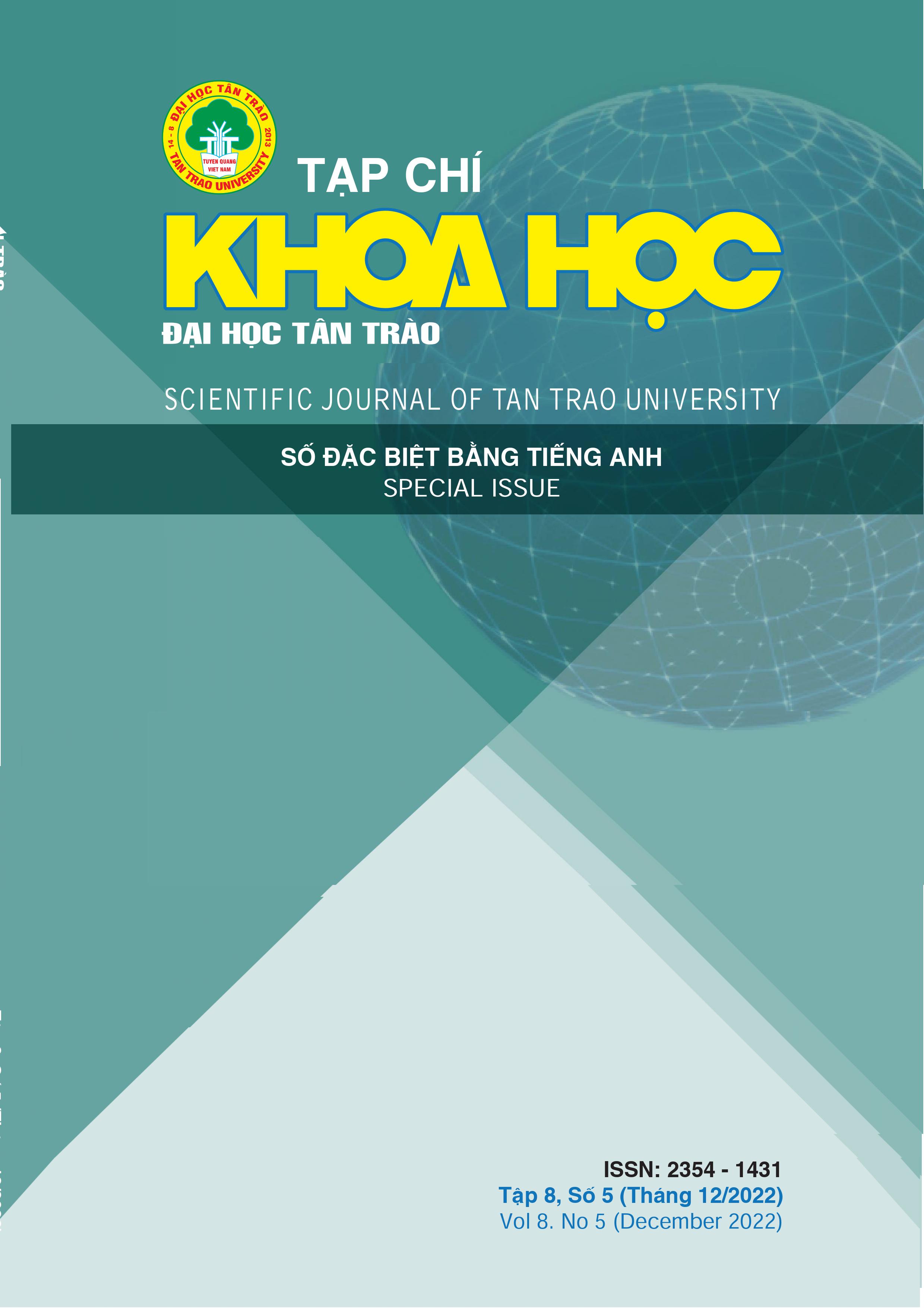INFLATION AND AXION DARK MATTER IN THE 3-3-1 MODEL
DOI:
https://doi.org/10.51453/2354-1431/2022/877Abstract
We consider a renormalizable theory, which successfully explains the number of Standard Model
(SM) fermion families and whose non-SM scalar sector includes an axion dark matter as well as
a field responsible for cosmological inflation. In such theory, the axion gets its mass via radiative
corrections at one-loop level mediated by virtual top quark, right handed Majorana neutrinos and
SM gauge bosons. Its mass is obtained in the range 4 keV÷ 40 keV, consistent with the one
predicted by XENON1T experiment, when the right handed Majorana neutrino mass is varied from
100 GeV up to 350 GeV, thus implying that the light active neutrino masses are generated from a low
scale type I seesaw mechanism. Furthermore, the theory under consideration can also successfully
accommodates the XENON1T excess provided that the PQ symmetry is spontaneously broken at
the 1010 GeV scale.
PACS numbers: 11.30.Fs, 12.15.Ff, 12.60.-i
Downloads
References
[1] Z. G. Berezhiani and M. Yu. Khlopov, Z.Phys.C - Particles and Fields (1991), 49, pp. 73; P. Sikivie, arXiv:2003.02206.
[2] D. Banerjee et al, Phys. Rev. Lett. 125, 081801 (2020); P. F. P´erez, C. Murgui, A. D. Plascencia, JHEP 2001 (2020) 091;
C. Smorra et al., Nature 575 (2019) No.7782, 310; Z. Wang, L. Shao, L X. Li, JCAP 07 (2020) 038 Phys. Rev. D 102,
(2020).
[3] J. E. Kim, Phys. Rev. Lett. 43,103 (1979); M. A. Shifman et al., Nucl. Phys. B.166, 493 (1980); M. Dine, W. Fischler and
M. Srednicki, Phys. Lett. B 104,199(1981).
[4] R. D. Peccei, in: Source and detection of Dark Matter and Dark Energy in the Universe, Preceedings of 4th International
Symposoum, DM 2000,arXiv:hep-ph/0009030.
[5] A. Berlin, R. T. D’Agnolo, S. A. R. Ellis, C. Nantista, J. Neilson, P. Schuster, S. Tantawi, N. Toro, K. Zhou,
arXiv:1912.11048
[6] F. Pisano and V. Pleitez, Phys. Rev. D 46, 410 (1992).
[7] P. H. Frampton, Phys. Rev. Lett. 69, 2889 (1992).
[8] R. Foot et al, Phys. Rev. D 47, 4158 (1993) .
[9] M. Singer, J. W. F. Valle and J. Schechter, Phys. Rev. D 22, 738 (1980).
[10] R. Foot, H. N. Long and Tuan A. Tran, Phys. Rev. D 50, 34 (R)(1994)
[11] J. C. Montero, F. Pisano and V. Pleitez, Phys. Rev. D 47, 2918 (1993).
[12] H. N. Long, Phys. Rev. D 54, 4691 (1996).
[13] H. N. Long, Phys. Rev. D 53, 437 (1996).
[14] P. B. Pal, Phys. Rev. D 52 (1995) 1659.
[15] A. G. Dias, C. A. de S. Pires and P. S. Rodrigues da Silva, Phys. Rev. D 68 (2003) 115009,
[16] J. G. Ferreira, C. A. de S. Pires, J. G. Rodrigues and P.S. Rodrigues da Silva, Phys. Lett. B 771 (2017) 199.
[17] A. G. Dias, J. Leite, D. D. Lopes and C. C. Nishi, Phys. Rev. D 98 (2018) 115017.
[18] A. E. C´arcamo Hern´andez, R. Martinez and F. Ochoa, Eur. Phys. J. C 76, no.11, 634 (2016).
[19] A. E. C´arcamo Hern´andez, N. A. P´erez-Julve and Y. Hidalgo Vel´asquez, Phys. Rev. D 100, 095025 (2019)
[20] D. T. Huong and H. N. Long, Phys. Atom. Nucl. 73 (2010) 791; H. N. Long, arXiv:1501.01852.
[21] V. Q. Phong, et al, Phys. Rev. D 99, 015035 (2019);M. J. Baker, M. Breitbach, J. Kopp, and L. Mittnacht, JHEP, 03
(2018) 114.
[22] A. Pilaftsis, Phys. Rev. D 56 (1997), 5431.
[23] XENON Collaboration, E. Aprile et al, Phys. Rev. D 102, 072004 (2020).
[24] D. Ghost and D. Sachdeva, arXiv:2007.01873
F. Takahashi, et al, arXiv:2006.14521.
A. E. C´arcamo Hern´andez, et al, Phys. Rev. D 101, 035005 (2020)
H. N. Long, et al, Nucl. Phys. B 943 (2019) 114629
R. Martinez and F. Ochoa, Phys. Rev. D 90 (2014) 015028
Q. H. Cao and D. M. Zhang, arXiv:1611.09337.
D. Cogollo, et al, arXiv:2008.03409.
Downloads
Published
How to Cite
Issue
Section
License

This work is licensed under a Creative Commons Attribution-ShareAlike 4.0 International License.
All articles published in SJTTU are licensed under a Creative Commons Attribution-ShareAlike 4.0 International (CC BY-SA) license. This means anyone is free to copy, transform, or redistribute articles for any lawful purpose in any medium, provided they give appropriate attribution to the original author(s) and SJTTU, link to the license, indicate if changes were made, and redistribute any derivative work under the same license.
Copyright on articles is retained by the respective author(s), without restrictions. A non-exclusive license is granted to SJTTU to publish the article and identify itself as its original publisher, along with the commercial right to include the article in a hardcopy issue for sale to libraries and individuals.
Although the conditions of the CC BY-SA license don't apply to authors (as the copyright holder of your article, you have no restrictions on your rights), by submitting to SJTTU, authors recognize the rights of readers, and must grant any third party the right to use their article to the extent provided by the license.


